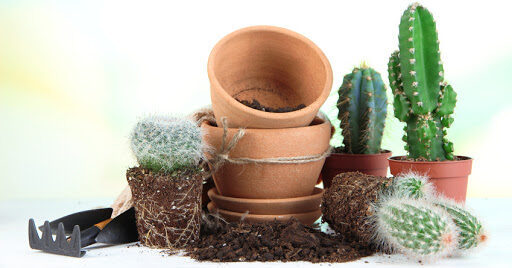After a long winter spent in dormancy, the cacti can be repotted as soon as the weather is fine. Good organization, adequate tools, thick gloves and courage are the necessary ingredients for a successful operation.
Contents
When to repot cacti?
In general, cacti and succulents should be repotted from spring to early summer, to give the roots time to settle in before winter. Young plants can stay in their pots for two to three years, depending on their growth capacity, but some vigorous species will need to be repotted annually. Large plants that are difficult to move can simply be covered with a good organic amendment.
How to recognize a cactus that needs repotting?
Cacti are often sold in small pots, in which they are a bit cramped. If you have recently bought a cactus, you can do a first repotting to give it more space.
Afterwards, if you notice that your cactus is not growing, if it looks weak, pale in color, or if you see its roots starting to come out of the pot, it needs to be repotted. Similarly, if you notice that your cactus stops growing or even starts to die back, these symptoms may indicate an attack of root lice.
The only solution to these pests is to remove the cactus from its pot, clean its roots and repot it in a healthy substrate.
Choosing the right pot for your cactus
Unlike other types of plants, cacti do not like too much space, so choose a pot that is too small rather than too big. A terracotta pot is preferable to a plastic one, and choose one that is wider rather than taller; the root system of a cactus tends to grow horizontally. Of course, your pot will have a hole at the bottom to drain off excess water.
Which substrate to use for repotting a cactus?
Cacti and succulents generally grow in very draining soils, dry and poor in organic matter. It is important that the substrate is light, sandy and aerated, to avoid asphyxiating the roots. Water must be able to drain quickly and allow the substrate to dry easily.
The substrate should be mostly mineral and not contain too much organic matter.
We advise you to plant your cacti and succulents in a mixture of one third coarse sand (river sand), one third potting soil and one third sifted garden soil (to be avoided if it is very clayey). You can also add 10 to 20% perlite, as it is a very light element that allows the substrate to be aerated.
For simplicity’s sake, you can also buy special cactus soil directly.
We also advise you to avoid calcareous substrates, as most cacti and succulents do not like limestone.
To be sure not to transmit diseases or parasites (such as root lice, for example), do not hesitate to sterilize the substrate by passing it in the microwave for a few minutes.
Handle your cactus without pricking yourself when repotting
To avoid pricking yourself when repotting, use “rose” type gloves that are now available in all garden centers, taking care not to squeeze the plant. You can also handle it by taking it just above the roots, there are less thorns.
Without gloves, you can also make twisted bands with newspaper, you will surround the plant and handle it by using the ends as a “handle”. And if you get pricked, here’s a tip for removing cactus thorns!
Before repotting the plant, remove all the soil from the roots, using a piece of wood to untangle the roots. With a scissor, cut the roots severely, leaving only 2 inches.
At the bottom of the pot, place a layer of pozzolan or gravel, then your soil mixture. Place your cactus, taking care to center it in the pot, and then cover the roots, packing them in well. Be careful not to push the plant too far into the pot above the collar, or it will rot.
Steps for repotting cacti
Proceed in dry weather, on subjects that have not been watered recently.
Potting
First of all, gently unpack the plant by tapping on the sides of the pot to loosen the root ball. Hold the cactus with a strip of newspaper, which will fit its body without hurting it, any traction on the stem and other twisting movements should be avoided, it is even better to break the pot to extract the plant without breaking it.
Shake the root ball to remove the remains of old substrate and examine the roots. It will be necessary to remove those which are soft, or dry.
Beware of root lice, if you see small whitish spots it is time to treat! You can also, if the weather is fine, leave your plant upside down, bare roots exposed to the sun for a few days: lice hate it!
Preparing the container
Choose a container a little larger than the previous one, with a diameter greater than 1 inch compared to the size of the plant’s body. The pot will have been bleached beforehand to avoid any propagation of cryptogamic diseases or parasites.
At the bottom of the pot, place a convex shard that will facilitate the water flow, you will cover it with a drainage layer (gravel, pebbles, pozzolan…) of a few inches.
In a separate container, prepare your mixture: the ideal being to conform to the needs of each subject (more or less mineral, more or less rich).
Most cacti will need a substrate composed of 1/3 potting soil, 1/3 coarse river sand and 1/3 garden soil.
Succulents will prefer a slightly richer mixture, you can add some compost or organic amendment to the preparation.
Installation
The delicate moment is approaching! If the plant is too big or too prickly, you can use polystyrene sheets that will serve as handles once they are placed on both sides of the cactus and well anchored in the prickles!
Then spread the roots at the bottom of the pot, on a light mound of suitable substrate that you had made beforehand, then proceed to the filling by taking care to maintain the plant in the center of the pot. Pack moderately.
Finally, install a layer of mineral material of about 0.5 inch on the surface to avoid crown rot. Coarse sand, small pebbles, white gravel, pebbles, the choice is yours.
Should you water your cactus after repotting?
Do not water your cactus immediately after repotting. Leave it alone for a while so that the roots can heal. This will also avoid the risk of rotting. 15 days to three weeks later, you can water it, or better, let nature do it because, of course, your cactus will live outside from the end of April to the middle of October!









